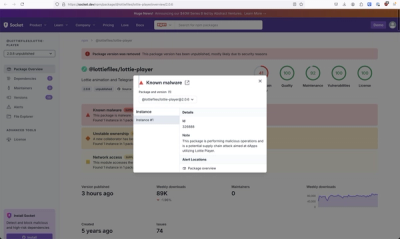screenfull.js
Simple wrapper for cross-browser usage of the JavaScript Fullscreen API, which lets you bring the page or any element into fullscreen. Smoothens out the browser implementation differences, so you don't have to.
This package is feature complete. No new changes will be accepted.
🔥 Want to strengthen your core JavaScript skills and master ES6?
I would personally recommend this awesome ES6 course by Wes Bos.
Install
Only 0.7 kB gzipped.
Download the production version or the development version.
$ npm install screenfull
Also available on cdnjs.
Why?
Screenfull
if (screenfull.enabled) {
screenfull.request();
}
Vanilla JavaScript
document.fullscreenEnabled = document.fullscreenEnabled || document.mozFullScreenEnabled || document.documentElement.webkitRequestFullScreen;
function requestFullscreen(element) {
if (element.requestFullscreen) {
element.requestFullscreen();
} else if (element.mozRequestFullScreen) {
element.mozRequestFullScreen();
} else if (element.webkitRequestFullScreen) {
element.webkitRequestFullScreen(Element.ALLOW_KEYBOARD_INPUT);
}
}
if (document.fullscreenEnabled) {
requestFullscreen(document.documentElement);
}
Support
Supported browsers
Note: In order to use this package in Internet Explorer, you need a Promise polyfill.
Documentation
Examples
Fullscreen the page
document.getElementById('button').addEventListener('click', () => {
if (screenfull.enabled) {
screenfull.request();
} else {
}
});
Fullscreen an element
const el = document.getElementById('target');
document.getElementById('button').addEventListener('click', () => {
if (screenfull.enabled) {
screenfull.request(el);
}
});
Fullscreen an element with jQuery
const target = $('#target')[0];
$('#button').on('click', () => {
if (screenfull.enabled) {
screenfull.request(target);
}
});
Toggle fullscreen on a image with jQuery
$('img').on('click', event => {
if (screenfull.enabled) {
screenfull.toggle(event.target);
}
});
Detect fullscreen change
if (screenfull.enabled) {
screenfull.on('change', () => {
console.log('Am I fullscreen?', screenfull.isFullscreen ? 'Yes' : 'No');
});
}
Remove listeners with:
screenfull.off('change', callback);
Detect fullscreen error
if (screenfull.enabled) {
screenfull.on('error', event => {
console.error('Failed to enable fullscreen', event);
});
}
See the demo for more examples, and view the source.
Fullscreen an element with Angular.js
You can use the Angular.js binding to do something like:
<div ngsf-fullscreen>
<p>This is a fullscreen element</p>
<button ngsf-toggle-fullscreen>Toggle fullscreen</button>
</div>
Fullscreen the page with Angular 2
import {Directive, HostListener} from '@angular/core';
import * as screenfull from 'screenfull';
@Directive({
selector: '[toggleFullscreen]'
})
export class ToggleFullscreenDirective {
@HostListener('click') onClick() {
if (screenfull.enabled) {
screenfull.toggle();
}
}
}
<button toggleFullscreen>Toggle fullscreen<button>
Methods
.request()
Make an element fullscreen.
Accepts a DOM element. Default is <html>. If called with another element than the currently active, it will switch to that if it's a decendant.
If your page is inside an <iframe> you will need to add a allowfullscreen attribute (+ webkitallowfullscreen and mozallowfullscreen).
Keep in mind that the browser will only enter fullscreen when initiated by user events like click, touch, key.
Returns a promise that resolves after the element enters fullscreen.
.exit()
Brings you out of fullscreen.
Returns a promise that resolves after the element exits fullscreen.
.toggle()
Requests fullscreen if not active, otherwise exits.
Returns a promise that resolves after the element enters/exits fullscreen.
.on(event, function)
Events: change error
Add a listener for when the browser switches in and out of fullscreen or when there is an error.
.off(event, function)
Remove a previously registered event listener.
.onchange(function)
Alias for .on('change', function)
.onerror(function)
Alias for .on('error', function)
Properties
.isFullscreen
Returns a boolean whether fullscreen is active.
.element
Returns the element currently in fullscreen, otherwise null.
.enabled
Returns a boolean whether you are allowed to enter fullscreen. If your page is inside an <iframe> you will need to add a allowfullscreen attribute (+ webkitallowfullscreen and mozallowfullscreen).
.raw
Exposes the raw properties (prefixed if needed) used internally: requestFullscreen, exitFullscreen, fullscreenElement, fullscreenEnabled, fullscreenchange, fullscreenerror
FAQ
How can I navigate to a new page when fullscreen?
That's not supported by browsers for security reasons. There is, however, a dirty workaround. Create a seamless iframe that fills the screen and navigate to the page in that instead.
$('#new-page-btn').click(() => {
const iframe = document.createElement('iframe')
iframe.setAttribute('id', 'external-iframe');
iframe.setAttribute('src', 'http://new-page-website.com');
iframe.setAttribute('frameborder', 'no');
iframe.style.position = 'absolute';
iframe.style.top = '0';
iframe.style.right = '0';
iframe.style.bottom = '0';
iframe.style.left = '0';
iframe.style.width = '100%';
iframe.style.height = '100%';
$(document.body).prepend(iframe);
document.body.style.overflow = 'hidden';
});
Resources
License
MIT © Sindre Sorhus



